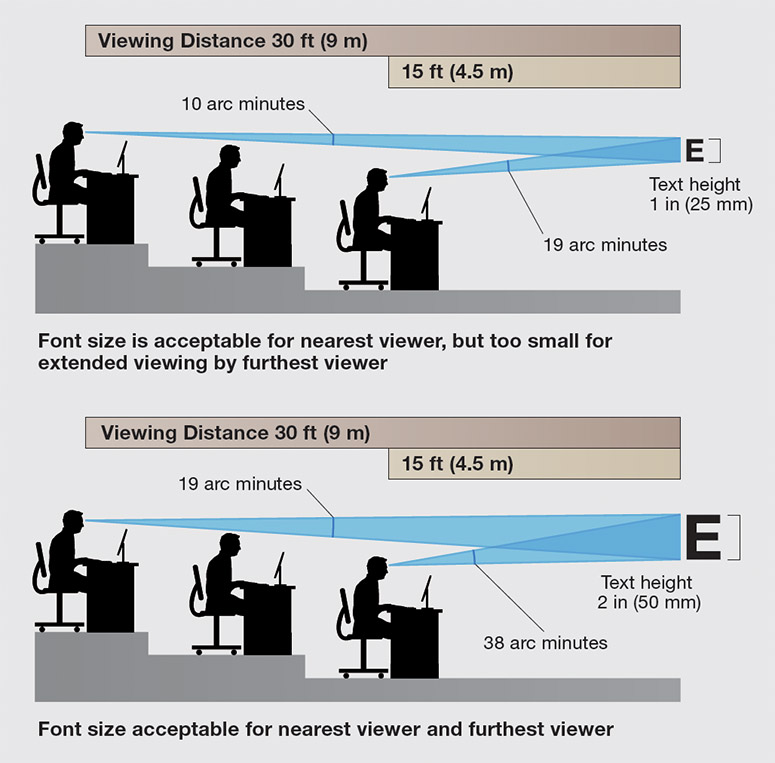Legibility is very important for any videowall application with sources that include alphanumeric text. Viewers should be able to easily read text at all intended viewing distances without eyestrain. Delivering adequately sized text can be accomplished by scaling up or enlarging the source to make fonts legible, or by rendering content with text at appropriate font sizes.
When considering legibility, it is important to take into account the distance between the farthest viewer and the videowall, and use this “worst case” scenario to determine how large source windows should be, or what font size should be specified when creating content. Additional display area may be required to provide adequate space for enlarged windows, which translates to larger displays, or extra rows or columns of screens.
Viewers should be able to easily read text at all intended viewing distances without eyestrain.
At a minimum, text on a videowall should occupy 10 vertical arc minutes of the viewer’s vision to be legible. However, this size may still appear to be too small for many viewers, and eyestrain is likely over long periods of time. A safer rule of thumb is for any displayed text to occupy at least 15 to 20 arc minutes of the furthest viewer’s vision.*

The example in Figure 2-13 illustrates an environment where the nearest viewer is 15 feet (4.5 m) from a videowall, and the furthest viewer is 30 feet (9 m) from the screens. The text is 1 inch (25 mm) high, which occupies 19 arc minutes of the nearest viewer’s vision. While this is acceptable, text read by a viewer 30 feet from the videowall only occupies 10 arc minutes, which is not acceptable for extended viewing. The sidebar provides more details on calculating arc minutes based on the text size and viewing distance.
To improve legibility for the furthest viewer, text should be rendered at a larger size, or source window sizes should be expanded. Figure 2-13 demonstrates that doubling the text height from 1 to 2 inches (25 to 50 mm) improves legibility, since the text now occupies 19 arc minutes for the furthest viewer.
From this illustration, it can be generalized that providing a text height of 1 inch (25 mm) for every 15 feet (4.5 m) of the maximum viewing distance will ensure legibility for the viewer. This is a good rule of thumb to follow when designing videowalls, especially in environments where critical information is displayed.
How to Calculate Arc Minutes
The number of arc minutes text and characters that occupy a person's viewing field can easily be calculated. All that is needed is a tape measure and a scientific calculator, or a mobile device running a scientific calculator app. Ensure the calculator is set to degrees, rather than radians.
Begin by measuring, or estimating, the distance from the videowall to the furthest viewing location in the room, as well as the height of the text on-screen. Then, this basic trigonometric formula can be used to calculate arc minutes:
- Arc Minutes
- = 60 x arctan (Text Height / Viewing Distance)
where arctan is the arctangent, or inverse tangent, and 60 denotes the number of arc minutes per degree.
- Example:
- For text 1 inch (25 mm) tall, viewed from 15 feet (4.5 m) or 180 inches,
- Arc Minutes
- = 60 x arctan (1 in/180 in) = 60 x arctan (0.0056)
- = 60 x 0.3183 = 19
If your calculator does not have an arctangent button, press the "inverse" button and then "tangent."
Pixel Density and Font Size
The pixel density of a display device is another factor that will impact font size. Text rendered at a specific font size will appear smaller on a high resolution display than on a lower resolution display of the same size. This is illustrated in Figure 2-14 for two 42 inch (107 cm) LCD panels, one at 1920x1080 and the other at 1366x768.

As a general rule of thumb, the pixel height of a font will be 30 to 35 percent larger than its point size.
It is also important to note that when referring to font size, or point size, a point is not equal to a pixel. In other words, 12 point font is not 12 pixels high, but rather is approximately 16 pixels high. The exact relationship between points and pixels varies by font. As a general rule of thumb, the pixel height of a font will be 30 to 35 percent larger than its point size.
Example: A videowall array comprised of 42 inch (107 cm) 1366x768 LCD panels is installed in a control room where the distance to the farthest viewer is 30 feet (9 m). The videowall has a pixel density of 37 PPI. For a 30 foot viewing distance, text on the screen should be at least 2 inches or 74 pixels high. Therefore, when creating content in Microsoft PowerPoint® or any other application, a font size of about 58 points should be applied.
It should be noted that if a source is intended to be magnified across multiple videowall screens, then the font size can be reduced accordingly. For an image spread over a 2x2 array of four screens, for example, the font selected can be one-half the size appropriate for viewing on a single screen. This can similarly be applied when a source window is to be enlarged.
Summary
To ensure that alphanumeric text presented on a videowall is legible for all viewers, use the following suggested rules of thumb:
- Apply a minimum text height of 1 inch (25 mm) on the screen for every 15 feet (4.5 m) of distance between the videowall and the furthest viewing position in the room.
- When rendering content for a videowall, the pixel height of a font is 30 to 35 percent larger than its point size.
* From Simpson, Robert S. (1996). “Videowalls: The Book of the Big Electronic Image,” Oxford, United Kingdom: Focal Press.